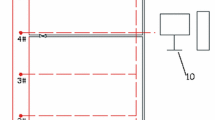Abstract
The detonation cell structure in dimethyl ether vapor and ethanol vapor–air mixtures was measured at atmospheric pressure and initial temperatures in the range of 293–373 K. Tests were carried out in a 6.2-m-long, 10-cm inner diameter tube. For more reactive mixtures, a series of orifice plates were used to promote deflagration-to-detonation transition in the first half of the tube. For less reactive mixtures prompt detonation initiation was achieved with an acetylene–oxygen driver. The soot foil technique was used to capture the detonation cell structure. The measured cell size was compared to the calculated one-dimensional detonation reaction zone length. For fuel-rich dimethyl ether mixtures the calculated reaction zone is highlighted by a temperature gradient profile with two maxima, i.e., double heat release. The detonation cell structure was interpreted as having two characteristic sizes over the full range of mixture compositions. For mixtures at the detonation propagation limits the large cellular structure approached a single-head spin, and the smaller cells approached the size of the tube diameter. There is little evidence to support the idea that the two cell sizes observed on the foils are related to the double heat release predicted for the rich mixtures. There was very little influence of initial temperature on the cell size over the temperature range investigated. A double heat release zone was not predicted for ethanol–air detonations. The detonation cell size for stoichiometric ethanol–air was found to be similar to the size of the small cells for dimethyl ether. The measured cell size for ethanol–air did not vary much with composition in the range of 30–40 mm. For mixtures near stoichiometric it was difficult to discern multiple cell sizes. However, near the detonation limits there was strong evidence of a larger cell structure similar to that observed in dimethyl ether air mixtures.













Similar content being viewed by others
References
Ciccarelli, G., Dorofeev, S.: Flame acceleration and transition to detonation in ducts. Progr. Combust. Sci. 34, 499–550 (2008)
Lee, J.H.S.: Dynamic parameters of gaseous detonations. Ann. Rev. Fluid Mech. 16, 311–336 (1984)
Knystautas, R., Lee, J.H., Peraldi, O., Chan, C.K.: Transmission of a flame from a rough to a smooth wall tube. Prog. Astron. Aeronaut. 106, 37–52 (1986)
Mogi, T., Horiguchi, S.: Explosion and detonation characteristics of dimethyl ether. J. Hazard. Mater. 164, 114–119 (2009)
Tieszen, S.R., Stamps, D.W., Westbrook, C.K., Pitz, W.J.: Gaseous hydrocarbon-air detonations. Combust. Flame 84, 376–390 (1991)
Ng, H.D., Chao, J., Tomoaki, Y., Lee, J.H.S.: Measurement and chemical kinetic prediction of detonation sensitivity and cellular structure characteristics in dimethyl ether-oxygen mixtures. Fuel 88, 124–131 (2009)
Shepherd, J.E.: Chemical kinetics of hydrogen–air-diluent mixtures. Progr. Astro. Aeronaut. 106, 263–293 (1986)
Chen, Z., Xiao, Q., Ju, Y., Zhao, Z., Chaos, M., Dryer, F.L.: High temperature ignition and combustion enhancement by dimethyl ether addition to methane–air flames. Proc. Combust. Inst. 31, 1215–1222 (2007)
Zhao, Z., Chaos, M., Kazakov, A.: Thermal decomposition reaction and a comprehensive kinetic model of dimethyl ether. Int. J. Chem. Kinet. 40, 1–18 (2008)
Joubert, F., Desbordes, D., Presles, H.N.: Detonation cellular structure in NO\(_{2}\)/N\(_{2}\)O\(_{4}\)–fuel gaseous mixtures. Combust. Flame 152, 482–495 (2008)
Moen, I.O., Murray, S.B., Bjerketvedt, A., Rinnan, R., Knystautas, R., Lee. J.H.S.: Diffraction of detonation from tubes into a large fuel-air explosive cloud. In: Nineteenth Symposium (International) on Combustion, pp. 635–644 (1982)
Campbell, C., Woodhead, D.W.: The ignition of gases by an explosion wave. I. Carbon monoxide and hydrogen mixtures. J. Chem. Soc. 129, 1572–1578 (1927)
Schott, G.L.: Observations of the structure of spinning detonation waves. Phys. Fluids 8, 850–885 (1965)
Acknowledgments
Financial support for the DME experiments was from MREL Group of Companies Limited and for the ethanol study from Natural Sciences and Engineering Research Council of Canada with Martec as industrial partner (CRDPJ434889-12).
Author information
Authors and Affiliations
Corresponding author
Additional information
Communicated by L. Bauwens.
This paper is based on work that was presented at the 24th International Colloquium on the Dynamics of Explosions and Reactive Systems, Taipei, Taiwan, July 28–August 2, 2013.
Rights and permissions
About this article
Cite this article
Diakow, P., Cross, M. & Ciccarelli, G. Detonation characteristics of dimethyl ether and ethanol–air mixtures. Shock Waves 25, 231–238 (2015). https://doi.org/10.1007/s00193-015-0554-7
Received:
Revised:
Accepted:
Published:
Issue Date:
DOI: https://doi.org/10.1007/s00193-015-0554-7




